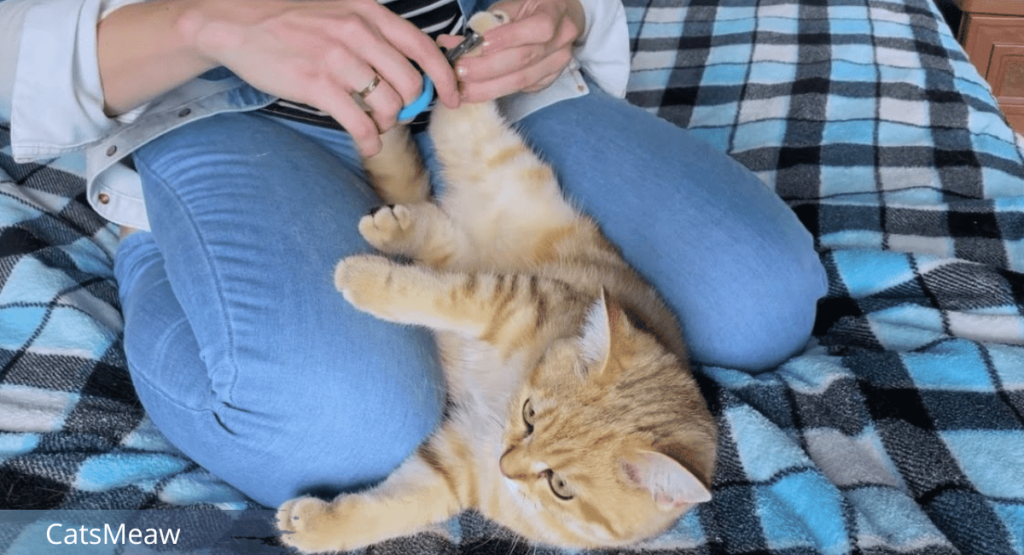Trimming your cat’s nails may not always be a pleasant experience, but it is an essential part of caring for your furry friend. There are numerous benefits to keeping those claws in check, both for you and your cat.
Unsure about the proper way to trim your cat’s nails? We have all the information you need to know.

Regular trims help prevent the nails from curling inward and digging into your cat’s sensitive paw pads, as well as avoiding snagging on items.
Table of Contents
Moreover, a good trim can also protect your furniture, rugs, and clothes. In this article, we will guide you through the process of trimming your cat’s nails safely and effectively. We will also provide you with some useful do’s and don’ts to make the process easier, safer, and less stressful for both you and your cat. With these tips, you’ll soon be able to trim your cat’s nails like a pro.
The Basics of How to Trim Your Cat’s Nails.
- When you’re ready to trim, position your cat in front of you, facing away. Some cats may willingly stay in this position, while others may require gentle restraint with a towel or blanket.
- Hold the nail clippers in your dominant hand, and with your other hand, lift one of your cat’s paws. It’s best to begin with the front paws. Gently squeeze your cat’s paw pad and the top of the paw with your thumb and the edge of your pointer finger. This will extend your cat’s claws.
- Examine each nail closely. You’ll notice a lighter, white outer tip, and a darker section starting slightly further up the nail. This darker section is called the “quick,” which is sensitive and can bleed if trimmed. Make sure to only trim the nail itself, avoiding the quick.
- Position the nail clippers around the tip of the nail and close them with a quick, firm motion. In most cases, a faster clip will result in a cleaner cut. Again, be careful to avoid cutting the quick. If you’re uncertain about how much to trim, err on the side of caution and take off less.
- Repeat this process for each nail on every paw. Your cat may need occasional breaks, or you may need to trim just one or two nails per session.
Related: Best Way To Know if Your Cat is in Pain
Do’s and Don’ts of Trimming Your Cat’s Nails:
Do’s
- Introduce nail trims when your cat is young. Start by gradually getting your cat used to having their paws handled. This helps them accept nail trims and reduces stress.
- Time your trims carefully. Play with your cat to tire them out, and then trim their nails when they are relaxed and calm. Avoid attempting a trim before meals or when your cat is energetic and playful.
- Pay attention to your cat’s reactions during the trim. If they need a break, allow them one. This makes it easier for them to cooperate.
- Properly restrain your cat. For their safety, you can wrap them up in a towel or blanket, exposing only the paw you need to trim. It might be helpful to have an extra person assist in positioning and holding your cat.
- Find the right tool. Choose sharp clippers that are suitable for your cat’s nail size. Ensure the clippers fit securely in your hand and can be operated with one hand. Textured grips can provide a more secure feel, boosting your confidence during nail trims.
- Reward your cat. Make each nail trim a positive experience by rewarding your cat with treats, praise, pats, and playtime.

Don’ts:
- Avoid pulling your cat’s paw out too far, as this will make them instinctively retract it. Keep their paw as close to their side as possible during the trim.
- Don’t rush the process. Trimming your cat’s nails requires time and patience. Never force your cat to comply.
- Trim one nail at a time. Trimming all the nails at once can overwhelm your cat. Start with one nail and take breaks if necessary.
- Don’t punish your cat. Avoid punishing your cat for not cooperating during the trimming process. This can create fear and anxiety, making future trims even more difficult.
- Don’t let your cat win the fight. If you sit down to trim their nails, try to complete at least one or two nails before giving in to their resistance. If they realize that resisting prevents the trim, they will continue doing so.
Related: Best Tips to Prevent Your Cat’s Attack
Trimming your cat’s nails requires patience and practice. If you’ve never done it before, consider asking your vet to guide you during your next appointment. They can provide additional tips specific to your cat and help you identify the quick in your cat’s nails to avoid any mishaps. With time, you and your cat will become more accustomed to nail trims, and the process should become smoother and easier for both of you.
